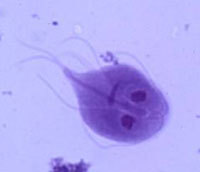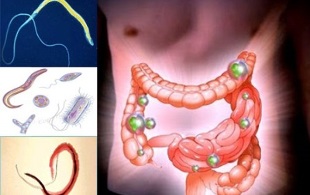
Parasites in biology are organisms that perform their vital activities at the expense of another organism in another biological species.
Such vital activity of the parasite does not benefit the host and, at best, the interaction does not lead to negative effects.
In the worst case, the parasite causes the death of the host. In this case, either the parasite escapes into the external environment or joint death.
Parasitic diseases of humans have been known practically since the primitive era of human existence. This fact arose in the process of observing the behavior of direct human ancestors - monkeys. Parasites living in wool are detected and removed from monkeys. This process has a very important nature in social interaction.
Human intolerance to the appearance of acne and holes in the skin also dates back to an early period of human existence. Some insect parasites in tropical zones can put their larvae on the skin. This leads to a reflex urge to displace them from the skin.
Various worms affecting the eyes, skin, and gastrointestinal tract have been described by ancient scientists. With the development and introduction of microscopy into medical practice in the 18th and 19th centuries, scientists identified the causes and modes of transmission of parasites that can cause specific diseases in humans.
- The early 20th century and the discovery of antiparasitic agents enabled humanity to cope with most parasitic diseases.
Thus, for almost the entire history of mankind, it has lived closely with various parasites. However, modern medicine allows for a rapid and fairly accurate diagnosis of the full spectrum of parasites, allowing physicians to treat such diseases in the shortest possible time and with minimal risk to patients.
Your GP will help you identify parasites, symptoms and treatment in your human body. Occasionally, infectious disease specialists in a narrower field - parasitologists - can be involved.
What are parasitic diseases?

Parasitic diseases are nosologies that occur after the introduction (invasion) of biological agents into the body. The latter refer to a group of human parasites. The symptoms of such diseases are extremely varied and depend on exactly the factor that has penetrated and carries out the activities of your life in the body.
According to the effect of parasites on the human body, they can generally be divided into the following groups:
- Exoparasites that affect human skin and hair.
- Toxic effects of parasitic waste products on the body.
- Parasite damages the gastrointestinal tract and lung mucosa.
- Formation of cysts and cysts in human organs. An increase in the size of such cysts and cysts leads to specific symptoms of organ compaction.
- Disruption of the normal passage of food through the gastrointestinal tract. This can lead to intestinal intussusceptions (more common in children) or the development of intestinal obstruction.
- Parasites in humans can cause hypersensitivity and the occurrence of non-specific allergic reactions.
- Microparasites can disrupt the function of blood cells, causing fever and poisoning.
- The effects of certain types of parasites on the body can not only lead to severe symptoms, but can also lead to organ failure or death.
Such a wide variety of negative effects of parasites are due to the variety of biological species in the body that enter the human organs. However, such biodiversity of parasites in the human body has allowed physicians to identify specific signs of parasitic diseases.
Parasites in the human body

The main modes of human infection with parasites depend on the life cycle of the biological organism, which is the pathogen of the parasitic disease.
Doctors identify ways a parasite can invade humans:
- Contact path.Insect is characterized by exoparasites as well as some helminths, mainly in aquatic life, whose larvae penetrate the human skin. In this way, it can infect a sick person, as well as dirty bedding, bedding, personal or public hygiene items, and so on.
- Stool-oral routeinfection. It occurs when cysts of a pathogen enter food after contact with infected feces, mainly from animals. Auto-invasion can also be observed - a person’s self-infection if personal hygiene is not followed, and so on.
- Dirt.The pathogen enters the bloodstream when infected insects break.
- Transmissible infection.The parasite enters the bloodstream when it is bitten by an insect carrying the disease. Most often, this mode of transmission is characteristic of the simplest parasites, such as malaria.
- Sexually transmitted infection.It is characteristic of both sexually transmitted diseases caused by parasites and certain helminths that can affect the human urinary and genital organs.
Protozoa, helminths (round and flatworms), insects, and some types of fungi are attributed to the causes of parasitic diseases.
The occurrence of humans with these species depends on the geographical and climatic zone. Therefore, medicines in each country keep their own records and list the parasites that are characteristic of them.
Biological organisms entering the human body have been studied in detail by both medical biologists and physicians, allowing for a clear classification of all biological species that cause parasitic diseases:
- The simplest organisms (amebiasis, balantidiasis, babeosis, Chagas disease, leishmaniasis, malaria, giardiasis, trypanosomiasis, toxoplasmosis, trichomoniasis).
- Beads. Sometimes the term worms is used (ascariasis, dicroceliosis, diphyllobothriasis, dranculosis, clonorchiasis, opisthorchiasis, strongyloidiasis, teniasis, fascioliasis, schistosomiasis, enterobiasis, echinococcosis).
- Exoparasites (lice (pubic, head, dress), demodicosis, fleas, bugs, scabies).
Signs of parasites in the human body

Unfortunately, there are no exact signs of parasites in the human body, and there are no symptoms that could indicate this or that type of parasitic infection. This leads to the fact that an accurate diagnosis, such as helminthiasis, requires specific tests.
On the other hand, almost all exoinfections are easily diagnosed - based on the clinical picture and the presence of a certain type of insect on the skin.
In general, all the symptoms of parasitic diseases can be divided into the following groups:
- Itchy skin and discomfort caused by external hair and skin parasites (fleas, lice and others). Acne-like and itchy skin rashes are often associated with conditions such as demodicosis (a special type of tick).
- Pain in different parts of the body caused by the introduction of a parasite into the skin and muscles (some worms that live in water).
- Eye pain, blurred vision.
- Pulmonary pain, coughing up secretions (this situation may be characteristic of migration of ascaris larvae in the lungs as well as cysts of the echinococcus of the lungs, etc. ).
- Nausea, vomiting, diarrhea are very common symptoms of most helminths that parasitize the digestive system.
- Jaundice, hepatobiliary disorders, hepatic failure. These symptoms occur in helminths affecting the liver and bile ducts, as well as in malaria at the height of the disease.
- Stomach pain.
- Intestinal obstruction due to occlusion of the intestinal lumen with a large number of roundworms or large representatives of flatworms.
All of these symptoms of the presence of parasites in the human body, in the absence of data on another pathology, prompt the physician to think about the parasitic disease in humans, and this will serve as a basis for diagnostic and laboratory tests.
Diagnosis of parasites in humans
Depending on the type of parasite invading the human body, one or the other research is being done. If we talk about external exoparasites, which are primarily insects, the diagnosis of the disease is usually limited to general examination as well as insect microscopy.
A general examination usually provides an accurate diagnosis and proper treatment or disinfection of the scalp or skin. In the case of demodicosis or scabies, the diagnosis can be easily made based on the location of the rash and the presence of itching.
Scratches taken for microscopy in this case confirm the diagnosis of intradermal parasites.
For gastrointestinal parasites, the main screening test (a diagnostic procedure that allows you to quickly and relatively informatively evaluate data on the presence or absence of a disease in a large number of people) is the analysis of feces.
- With a special microscopic examination of the stool, the laboratory assistant assesses worm eggs, dead worms, cyst capsules, etc.
Based on the morphology of helminth eggs, you can almost accurately determine the type of worm that parasitizes the body. Sometimes segments of tapeworms in the feces are determined macroscopically. They are then examined under a microscope to determine the appearance of flatworms parasitizing the gastrointestinal tract.
In some cases, such as when it is impossible to diagnose parasites in the body by analyzing stool, or non-informative, immunoassays are used. They make it possible to assess the presence of antibodies against certain types of helminth samples. Unfortunately, due to the special immunological relationship between the human immune system and the parasite, antibody levels in some cases do not reflect the true picture of the disease.
In case of malaria, a thick drop of blood is tested for Plasmodium malaria. In addition, general blood counts, leukocyte levels, and all biochemical parameters of the blood, especially the liver, are assessed.
The presence of elevated blood eosinophil levels is a common sign not only of allergic diseases but also of helminthic invasions. This is the first "bell".
Sometimes helminths in the gastrointestinal tract are diagnostic results during contrast radiographs, cystoscopy, FGDS, and colonoscopy.
How to get rid of parasites in the human body?

Parasitic infections should only be treated by a doctor, following certain rules.
Self-medication and traditional medicine in such cases do not lead to improvement and can sometimes be fatal.
It is also important to provide preventative treatment for all family members and relationships.
Human exoparasites that parasitize hairy areas of the body are killed with special disinfectants. Generally, a single treatment followed by hygienic washing is sufficient to kill the exoparasites.
When it comes to the skin type of parasites (scabies, demodectic scabies), special ointments containing insecticides are used against such organisms.
anthelmintics are used against roundworms and flatworms that act specifically on helminths in the main lumen of the gastrointestinal tract. Depending on the biological type of helminth, different treatment regimens are used (from one tablet to a series of courses).
Such medications should be used under strict medical supervision to recognize the negative and side effects of the medications in a timely manner.
No other treatment method, detoxification program, and so on can lead to the complete death of parasites in the body and, as a result, the recovery of a person.



























